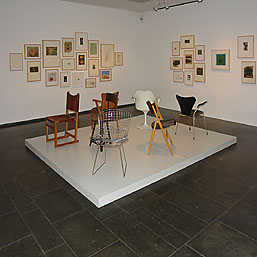2006 In the Garden of Reality II
20 October 2006 - 9 April 2007
In the Garden of Reality – Part II
Stars for Kolumba – last Part
What is a mechanical wall clock doing in an illustration of the Annunciation to the Virgin? A Book of Hours from Bruges from 1475, opened to a double page, sparks a dialogue between things and works (of art), which this last exhibition at the old location is presenting as the epitome of Kolumba’s collection. With works selected from out of six centuries, the exhibition focuses on the unity of creation and raises the question as to the fundaments and ethical responsibility of creating. In the second part of the »Garden of Reality« as well, Stefan Lochner’s »Madonna with the Violet« stands again as the central focus (more information to Part I in the Menu Archive). However, the emphasis is on a selection from the collection of works and forms that Werner Schriefers had presented as a gift to Kolumba in 2002. This generous donation of around 8000 well-designed utilitarian objects ties in with the origins of the museum, founded in 1853 as a museum of the archdiocese in the spirit of achieving a model collection. On display you will find ceramics and glasses as well as technical equipment made from 1910 to the 1960s. A book published to accompany this exhibition displays a cultural history of things in the 20th century. In it, we introduce groups of products and materials, famous designers and firms, asking whether everyday things need to be aesthetically pleasing. This is a book to look at and to enjoy reading! (See new publications).
»Everything that is, must appear, and nothing can appear without a shape of its own; hence there is in fact nothing that does not in some way transcend its functional use […] By the same token, namely in its sheer worldly existence, every thing also transcends the sphere of pure instrumentality once it is completed. The standard by which a thing’s excellence is judged is never mere usefulness, as though an ugly table will fulfil the same function as a handsome one, but its adequacy or inadequacy to the idea of what it should look like.« (Hannah Arendt)
In the Garden of Reality – Part II
Stars for Kolumba – last Part
What is a mechanical wall clock doing in an illustration of the Annunciation to the Virgin? A Book of Hours from Bruges from 1475, opened to a double page, sparks a dialogue between things and works (of art), which this last exhibition at the old location is presenting as the epitome of Kolumba’s collection. With works selected from out of six centuries, the exhibition focuses on the unity of creation and raises the question as to the fundaments and ethical responsibility of creating. In the second part of the »Garden of Reality« as well, Stefan Lochner’s »Madonna with the Violet« stands again as the central focus (more information to Part I in the Menu Archive). However, the emphasis is on a selection from the collection of works and forms that Werner Schriefers had presented as a gift to Kolumba in 2002. This generous donation of around 8000 well-designed utilitarian objects ties in with the origins of the museum, founded in 1853 as a museum of the archdiocese in the spirit of achieving a model collection. On display you will find ceramics and glasses as well as technical equipment made from 1910 to the 1960s. A book published to accompany this exhibition displays a cultural history of things in the 20th century. In it, we introduce groups of products and materials, famous designers and firms, asking whether everyday things need to be aesthetically pleasing. This is a book to look at and to enjoy reading! (See new publications).
»Everything that is, must appear, and nothing can appear without a shape of its own; hence there is in fact nothing that does not in some way transcend its functional use […] By the same token, namely in its sheer worldly existence, every thing also transcends the sphere of pure instrumentality once it is completed. The standard by which a thing’s excellence is judged is never mere usefulness, as though an ugly table will fulfil the same function as a handsome one, but its adequacy or inadequacy to the idea of what it should look like.« (Hannah Arendt)


